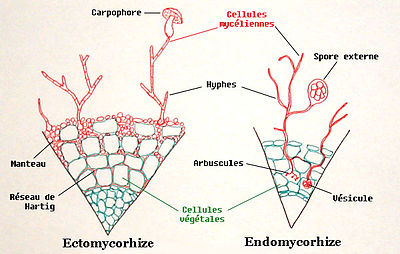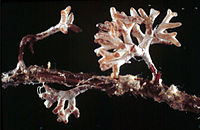Mycorrhiza
- This page is under construction. Some material is prepared here: Research page:Mycorrhiza
- Topic in Gardening courses
A mycorrhiza[1] is a symbiotic (generally mutualistic, but occasionally weakly pathogenic) association between a fungus and the roots of a higher plant. In a mycorrhizal association, the fungus colonizes the host plant's roots, either intracellularly or extracellularly. They are an important component of soil life.[2]
Mycorrhiza literally means “fungus-root”. The hyphae or the microscopic filaments of a fungus penetrate the root of a plant. The hyphae form a network or mycelium in the soul around the root. This greatly increases the plant's ability to absorb water and minerals. The fungus shares water and minerals with the plant and the plant shares carbohydrates produced by photosynthesis with the fungus. Some plants are very dependent on the minerals they receive from the fungus, for example some plants are entirely dependent to receive phosphorous in this way.[3]
Definitions of mycorrhiza
- "Mycorrhizas are symbiotic associations essential for one or both partners, between a fungus (specialised for life in soils and plants) and a root (or other substrate-contacting organ) of a living plant, that is primarily responsible for nutrient transfer. Mycorrhizas occur in a specialised plant organ where intimate contact results from synchronised plant-fungus development."[4]
- "A mycorrhiza is a symbiotic (generally mutualistic, but occasionally weakly pathogenic) association between a fungus and the roots of a vascular plant. In a mycorrhizal association, the fungus colonizes the host plant's roots, either intracellularly as in arbuscular mycorrhizal fungi (AMF), or extracellularly as in ectomycorrhizal fungi. They are an important component of soil life and soil chemistry.[5]
- "The symbiotic association of the mycelium of a fungus with the roots of a seed plant"[6]
How many plants form mycorrhiza
- "While it is clear that the majority of plants form mycorrhizas, the exact percentage is uncertain, but it is likely to lie somewhere between 80% and 90%. In many of these associations between 10% and 30% of the food produced by the plant moves through to the fungi."[7]
- "At least 95% of all plants have the mycorrhizal relationship. (One big exception to the mycorrhizal rule is the mustard family (the Brassicaceae). This family of plants with about 3000 species is mostly devoid of the helpful fungus and, in the odd case where mycorrhizae do exist in this family, it is at best a weak relationship.)"[8]
The nutrients that are exchanged
The length of roots and extended hyphens
- Do you know how long all the root segments of the entire root system of a single rye plant can become? According to Brian Capon in his book 'Botany for gardeners' it was once measured. The figure is unbelievable: 380 miles or 630 km.[9]
Types of mycorrhiza
Endomycorrhiza
They are the most abundant type of mycorrhiza and the most ancient. It is likely that these fungi originated between 350 and 450 million years ago and probably played an essential role in the colonization of land by the plants. The hyphae of endomycorrhizal fungi penetrate directly into the starch-storing cortex cells of the plant root.
Ectomycorrhiza
The hyphae of ectomycorrhizal fungi form a mantle around the root and also grow into the spaces between root cells - but do not penetrate the root cells. The hyphae form a net-like covering, called a Hartig net[10], around the cells.
Ectomycorrhizal associations are formed mostly on the fine root tips of the host plant. They are more abundant in topsoil layers that contain humus.
Ectomycorrhizas are typically formed between the roots of around 10% of plant families, mostly woody plants including for example the birch, eucalyptus, oak, pine, and rose families, and certain types of fungi. Some of these fungi are symbiotic with only one particular genus of plant, while other form mycorrhizas with many different plants. An individual tree may have 15 or more different fungal ectomycorrhizal partners at one time. Thousands of ectomycorrhizal fungal species exist.
Ericoid mycorrhiza
Ericoid mycorrhiza[11] are a symbiotic relationship between fungi and the roots of plants from the order Ericales (for example tea, blueberry, azalea).
Gallery
- Try to later embed these images into the text
See also
References
- ↑ See Botany for gardeners by Brian Capon, chapter 6
- ↑ Mycorrhiza - Wikipedia
- ↑ A plant's best friend, by Gerry Barclay (pdf)
- ↑ Mycorrizhas.info
- ↑ Mycorrhiza - Wikipedia
- ↑ Merriam-Webster
- ↑ Australian Fungi Website
- ↑ A plant's best friend, by Gerry Barclay (pdf)
- ↑ Botany for Gardeners, by Brian Capon
- ↑ Hartig net is a hyphal network, that extends into the root, penetrating between epidermal and cortical cells. This network is a site of nutrient exchange between the fungus and the host plant.
- ↑ Ericoid mycorrhiza - Wikipedia
External links
- An online textbook to provide current information about mycorrhizal associations
- International Mycorrhiza Society
- Mycorrhiza Literature Exchange "Posted here are the abstracts of almost all journal articles dealing with mycorrhizae from 1991 through 2009 (over 11,000 citations), as well as citations to some 260 mycorrhizal reviews, over 70 mycorrhizal books, many mycorrhizal theses and dissertations. Also included is almost every article ever published dealing with water relations and mycorrhizae".
- SpringerLink: Online magazine about mycorrhiza
Videos
- Arbuscular mycorrhiza A collection of videos in the Mashpedia Life Encyclopedia.
- "Ever wonder how mycorrhizal fungi improve plant nutrition? This video shows how mycorrhizal hyphae access, unlock and transport soil nutrients."
- "Michael Melendrez talks about the role of Mycorrhiza: endo/ecto." Part of the content: Grass roots of any kinds of grass grow with many mycorrhiza, which is why lawns and grass land still keeps much of their fertility despite otherwise wrong agricultural methods.









